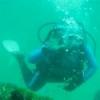
Those obsure or non traditional scuba tips & tricks
#1

Posted 11 June 2009 - 04:50 PM
One I shared repeatedly over this past weekend and last night while teaching OW classes was simply when putting a yoke regulator onto a tank, I find it a good habit to hold the left side of the yoke (when standing behind the tank and first stage) down with your left thumb when tightening it. The yoke has a tendency to roll to the right when tightening it which pins it to the tank knob. On some tanks with long rubber knobs, it makes it difficult to then turn the tank on and off (which can be of some concern in the event you need to shut a tank down quickly).
Another is that I don't use a clip to stow my pressure gauge. I feed it under my arm and through my BC arm hole. It then comes out at an angle directly in front of me. Easy to locate, easy to read, but still close to me without dragging. And I never have to worry about it coming out of a clip.
Maybe simple to some, but may new to others. What are your lesser talked about tips & tricks?
Once in a while, it is good to step back, take a breath, and remember to be humble. You'll never know it all - ScubaDadMiami. If you aren't afraid of dying, there is nothing you can't achieve - Lao-tzu. One dog barks at something, the rest bark at him - Chinese Proverb.
#2

Posted 11 June 2009 - 07:00 PM
The third of my two things (!) is that I don't use a clip for my octopus when recreational-diving. I fold the hose and push it from the back behind the right vertical strap, so the 2nd stage is under my arm. And fourthly (!!) I stow my pressure gauge between the velcro cummerbund and the belt that's generally buckled over it (doesn't apply to all gear configurations).
#3

Posted 11 June 2009 - 10:42 PM
I used to do this, but saw a picture of me Bruce took in Wakatobi and it was still dangling (perk of being short!) Now I have it on double hose retainer clip (although you actually only need a "single" - with two o rings either side to keep it from slipping around. Nice and tidy now! So for vertically challenged divers that dont' want to shorten their hose, this is what I recommend - one of these:I stow my pressure gauge between the velcro cummerbund and the belt that's generally buckled over it (doesn't apply to all gear configurations).
#4

Posted 12 June 2009 - 10:01 AM
Every existing thing is born without reason, prolongs itself out of weakness, and dies by chance. - Jean-Paul Sartre
I feel the urge, the urge to submerge! -ScubaHawk - Raptor of the Deep !
WHO DAT!!!!
#5

Posted 12 June 2009 - 08:04 PM
The way I've found to compensate for this is to use a file to sharpen the dive knive, rather than a smooth sharpening stone. Just stroke the file along the side of the blade, towards the cutting edge. When finished, the cutting edge of the blade will be sharp, but rough. Using a file produces mini-serrations, which give the cutting edge of the knife greater durability.
Rick
You cannot help the poor by destroying the rich.
You cannot strengthen the weak by weakening the strong.
You cannot bring about prosperity by discouraging thrift.
You cannot lift the wage earner up by pulling the wage payer down.
You cannot further the brotherhood of man by inciting class hatred.
You cannot build character and courage by taking away people's initiative and independence.
You cannot help people permanently by doing for them, what they could and should do for themselves.
--Abraham Lincoln
#6

Posted 12 June 2009 - 09:17 PM
#7

Posted 13 June 2009 - 12:01 PM
Titanium knives are both hard and rust resistant. Not as shiny, but twice as sharp. You can forget to rinse them and they don't care. Of course, you can buy SS knives for $5 a piece nowadays so not that great of an issue.Or use a harder rust-prone blade and protect it before each dive. I find brushing on liquid dry suit wax works very well - more durable and a lot less messy than Vaseline.
Tech Support - The hard we do right away; the impossible takes us a little longer...
"I like ponies on no-stop diving. They convert "ARGH!! I'M GOING TO DIE" into a mere annoyance." ~Nigel Hewitt
#8

Posted 13 June 2009 - 09:24 PM
For those with sticky ears...shoot a little Nasal Spray into your nose and then clear you ears a few times. this gets the dilating agent up into the Eaustatian tubes
I use a snorkle retainer ring attached to my right chest D-ring as a holder for my second stage on the boat so that the second stage doesn't hang down to the seat where it can get sat on or smashed under someone elses tank. Also works for the second stage off of a pony bottle
#9

Posted 14 June 2009 - 10:59 AM
The dive (on Bridge Span 12) started off OK but, on the ascent, we ran into a drifting cloud of stinging purple jellies... "Drat (or words to that effect)...", I thought, "... and me without my [add suitable expletive here] hood on, today" -- probably not a big thing for those of you with hair, but I'm not that fortunate.
Needless to say, the safety stop - right in the middle of the swarm - was a great test of character. Thankfully there was white vinegar on board the Better Bottom Time, but sitting there smelling like a garden salad for an hour was no fun, either.
At the hotel that night, the simple shower cap (with a small hole in the top to expel any bubbles) went into my BC for future deployment should I be this unlucky again (TIP: A rubber band around it keeps it small and tidy).
#10

Posted 14 June 2009 - 01:26 PM
I always carry a shower cap (you know, the ones the hotels put out for you), after a rather painful experience off Panama City Beach.
The dive (on Bridge Span 12) started off OK but, on the ascent, we ran into a drifting cloud of stinging purple jellies... "Drat (or words to that effect)...", I thought, "... and me without my [add suitable expletive here] hood on, today" -- probably not a big thing for those of you with hair, but I'm not that fortunate.
Needless to say, the safety stop - right in the middle of the swarm - was a great test of character. Thankfully there was white vinegar on board the Better Bottom Time, but sitting there smelling like a garden salad for an hour was no fun, either.
At the hotel that night, the simple shower cap (with a small hole in the top to expel any bubbles) went into my BC for future deployment should I be this unlucky again (TIP: A rubber band around it keeps it small and tidy).
I wear a beanie to keep my long hair out of my face, but that sounds like a good use of one too!
Teresa,
The original Mermaid Lady
Bass player for the band formerly known as Opulent.
"'I'm only wearing black until they come out with something darker..."
#11

Posted 15 June 2009 - 02:12 PM
After performing your reg checks:
- Note the tank pressure.
- Close the tank valve fully but do not press any purge valves.
- Wait about a minute.
- Check to see if the tank pressure is lower than your first reading. If it is significantly lower (more than 600-800psi), you have a leak somewhere between the tank valve and the second stage (yes, you might be able to hear the hissing but, on a noisy boat, you may not...).
- Try re-seating the first stage (after purging the reg) and check/replace the tank O ring as necessary.
- Test it again. If it persists, dunk the whole rig to find the leak...
- IMPORTANT: Don't forget to turn your tank on again before striding off the boat!
Edited by Keith B, 15 June 2009 - 02:15 PM.
#12

Posted 15 June 2009 - 06:02 PM
Requires good buoyancy control of course. How many of us can simply stop in the water and roll over to face upwards without continuing to descend? How many can swim along just over a coral bottom, then roll over so as to look backwards whilst continuing to fin without grinding into said coral? All of us should be able to do both.
#13

Posted 15 June 2009 - 07:29 PM
Jacques Yves Cousteau
0 user(s) are reading this topic
0 members, 0 guests, 0 anonymous users





















